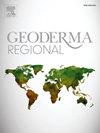葡萄废生物炭在污染土壤中固定化潜在有毒元素的研究
IF 3.1
2区 农林科学
Q2 SOIL SCIENCE
引用次数: 0
摘要
从农业废弃物中提取的生物炭被认为是固定受污染土壤中潜在有毒元素 (PTE) 的一种环境可持续方法。本研究调查了从葡萄残渣中提取的生物炭在固定受污染土壤中铅、镍、锰、铜和钴等 PTEs 方面的功效。从伊朗阿拉克的三种土地利用类型(农业、城市和工业)中共收集了 110 份表层土壤样本。使用二乙烯三胺五乙酸(DTPA)萃取法分析了 PTEs 的生物可利用部分。通过 X 射线衍射、场发射扫描电子显微镜、傅立叶变换红外光谱(FTIR)、能量色散 X 射线光谱和布鲁瑙尔-艾美特-泰勒(BET)分析,对生物炭的特性进行了表征。生物炭以 5%(重量比)的比例加入受污染的土壤中,并培养两个月。结果表明,施用生物炭提高了土壤性质,包括 pH 值、电导率、阳离子交换容量、有机质和土壤微生物呼吸。同时,铜、镍、铅和钴的 DTPA 可提取浓度分别从 7.26、1.83、5.82 和 0.25 毫克/千克降至 5.54、0.86、4.06 和 0.18 毫克/千克,生物利用率相应降低了 24% 至 79%。傅立叶变换红外光谱(FTIR)和 BET 分析表明,生物炭中带有负电荷的官能团和高比表面积是造成生物利用率降低的原因。随机森林分析进一步表明,有机物和土壤微生物呼吸是生物炭添加后降低 PTE 生物利用率的最有影响的因素。这些发现强调了葡萄渣衍生生物炭作为一种有效的改良剂来减轻土壤中 PTE 污染的潜力。本文章由计算机程序翻译,如有差异,请以英文原文为准。
Immobilization of potentially toxic elements by grape waste biochar in contaminated soils
Biochar derived from agricultural waste is recognized as an environmentally sustainable method for immobilizing potentially toxic elements (PTEs) in contaminated soils. This study investigated the efficacy of biochar produced from grape residues in immobilizing PTEs such as Pb, Ni, Mn, Cu, and Co in contaminated soils. A total of 110 surface soil samples were collected from three land-use types (agricultural, urban, and industrial) in Arak, Iran. The bioavailable fractions of PTEs were analyzed using the diethylenetriamine penta acetic acid (DTPA) extraction method. The properties of biochar were characterized through X-ray diffraction, field emission scanning electron microscopy, Fourier-transform infrared spectroscopy (FTIR), energy-dispersive X-ray spectroscopy, and Brunauer-Emmett-Teller (BET) analysis. Biochar was incorporated into the contaminated soils at a rate of 5 % (w/w) and incubated for two months. The results indicated that the biochar application enhanced soil properties, including pH, electrical conductivity, cation exchange capacity, organic matter, and soil microbial respiration. Simultaneously, the DTPA-extractable concentrations of Cu, Ni, Pb, and Co decreased from 7.26, 1.83, 5.82, and 0.25 mg/kg, to 5.54, 0.86, 4.06, and 0.18 mg/kg, respectively, corresponding to reductions of 24 % to 79 % in bioavailability. The reductions were attributed to the functional groups with negative charges and the high specific surface area of the biochar, as identified by FTIR and BET analyses. A random forest analysis further revealed that organic matter and soil microbial respiration were the most influential factors in in reducing the bioavailability of PTEs following biochar amendment. These findings underscore the potential of grape residue-derived biochar as an effective amendment for mitigating PTE contamination in soils.
求助全文
通过发布文献求助,成功后即可免费获取论文全文。
去求助
来源期刊

Geoderma Regional
Agricultural and Biological Sciences-Soil Science
CiteScore
6.10
自引率
7.30%
发文量
122
审稿时长
76 days
期刊介绍:
Global issues require studies and solutions on national and regional levels. Geoderma Regional focuses on studies that increase understanding and advance our scientific knowledge of soils in all regions of the world. The journal embraces every aspect of soil science and welcomes reviews of regional progress.
 求助内容:
求助内容: 应助结果提醒方式:
应助结果提醒方式:


